SF Manga 101: Planetes and 7 Billion Needles
Glenn Hough (gallyangel) is a nonpracticing futurist, an anime and manga otaku, and is almost obsessive about finishing several of the lists tracked on WWEnd. In this series on SF Manga Glenn will provide an overview of the medium and the place of science fiction within it.
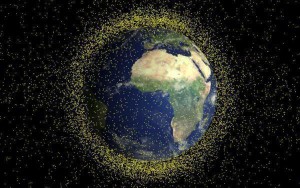 Over the last several years, there have been a few articles published on space junk. This is an issue which generally simmers in the background of space travel, with the occasional additional emphasis period. Some of those articles focus on the need for treaty work to help limit the amounts of new junk added to the ever expanding cloud, while others talk about ways in which junk could be cleaned up with robot satellites specifically designed for that purpose. There are approximately 22,000 pieces of space trash being actively tracked. The experts think that there are in the neighborhood of 500,000 objects in the 1 to 10 cm size range which aren’t being tracked. A 1 cm size object, like a hexagon nut for instance, doesn’t sound very dangerous, but this nut is traveling at orbital speed. Do the words “Explosive Decompression” mean anything to you?
Over the last several years, there have been a few articles published on space junk. This is an issue which generally simmers in the background of space travel, with the occasional additional emphasis period. Some of those articles focus on the need for treaty work to help limit the amounts of new junk added to the ever expanding cloud, while others talk about ways in which junk could be cleaned up with robot satellites specifically designed for that purpose. There are approximately 22,000 pieces of space trash being actively tracked. The experts think that there are in the neighborhood of 500,000 objects in the 1 to 10 cm size range which aren’t being tracked. A 1 cm size object, like a hexagon nut for instance, doesn’t sound very dangerous, but this nut is traveling at orbital speed. Do the words “Explosive Decompression” mean anything to you?
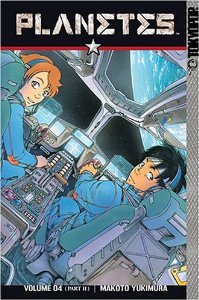 Enter Planetes by Makoto Yukimura. Tokyopop had this to say:
Enter Planetes by Makoto Yukimura. Tokyopop had this to say:
In the 2070’s, mankind has established a mining base on the moon and dispatched men to explore Mars. The first manned mission to Jupiter is also in progress. As a result of this interplanetary activity, space debris is increasing and its collection has become a new profession. In the 1st volume of Makoto Yukimura’s Planetes, we meet Yuri, Hachimaki, and Fee. Hachimaki’s dream is to buy his own spaceship. He thinks he can earn money quickly by joining the crew of the first expedition to Jupiter. Yuri lost his wife in a space travel accident, and became a debris collector out of a desperate desire to discover some remembrance of her. Fee takes great pride in her profession and works very hard, having left behind her husband and young son on earth. In a dark and cruel universe, each of these space junkers grapples with his or her own personal problems.
Reading this manga, I get an immediate sense of Arthur C. Clarke. There’s the same detailed technical attention to space travel and living in space, but with an emotional tenor Clarke rarely had. There’s the same sort of pushing the human sphere to space. Space is where one can live and work, or it’s a place where one can commute to for work. Space is now part of the human realm. It’s no longer only the realm of childhood dreams and that infinitesimally small sliver of highly trained individuals, sponsored by competing governments. We’re not yet at the point were just anyone can go into space, but the option to go now exists for a far vaster segment of the populous, who come from every corner of the globe.
One of the other things which Planetes gives us is a slice-of-life feel. That with Yuri, Hachimaki and Fee, we’re just following along with their ordinary doings, which just happen to include working in space. Instead of SF centered around the technical or adventurous side of space travel, with little to no interaction with the ground based human population, this is fiction that integrates both worlds. With the vast increase of people who can go into space, space activity has taken on more human detail. The passions and the pains of humanity moved right into this new sphere of human endeavor.
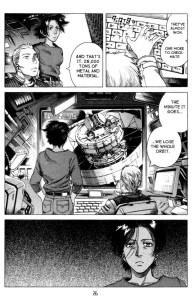 As I sit here flipping through the manga, I’m struck by the details of the mission to Jupiter, juxtaposed with the political activism that tries to tone down the war drums on the planet. War in space has one very fatal consequence, it increases the amount of debris exponentially, making travel there far more hazardous, to the point where certain orbital routes have to be closed. There is also the baseball game on Mars while the Hanshin Tigers go for another Japanese title. The dead sent into orbit and the near death experience of the living. Debris storms on orbit, marriage and babies. Planetes has a little bit of everything.
As I sit here flipping through the manga, I’m struck by the details of the mission to Jupiter, juxtaposed with the political activism that tries to tone down the war drums on the planet. War in space has one very fatal consequence, it increases the amount of debris exponentially, making travel there far more hazardous, to the point where certain orbital routes have to be closed. There is also the baseball game on Mars while the Hanshin Tigers go for another Japanese title. The dead sent into orbit and the near death experience of the living. Debris storms on orbit, marriage and babies. Planetes has a little bit of everything.
And we come full circle, an orbit. It starts and ends with the garbage of human space exploration, which has to be cleaned up, or the costs in monetary value and human lives becomes so high, going off planet become impossible.
The five volumes of Planetes were produced by our dear departed friends at Tokyopop. Complete sets do come up on Ebay from time to time. Individual issues are available in the secondary online markets and they run from not bad to no, I think not, price wise. Planetes has also been archived at multiple sites for free, like mangafox.me, mangawall.com, or mangapanda.com.
It was not until after I first found my way to WWEnd and started to pay very close attention to some of the lists that I stumbled across Clement and eventually got to Needle. When Clement first wrote about that deadly game of chase, played out between two aliens roaming across the galaxy and ending on Earth, there weren’t 7 billion of us. Hence the need and source for an updated title.
Vertical has this to say about volume one of 7 Billion Needles:
Hikaru Takabe may not be the most social of teens. Always sporting her headphones, she gives off an aloof aura that rubs her classmates the wrong way. But her not being part of the crowd takes on a different dimension when she becomes involved in an intergalactic game of cat and mouse.
Inspired by Needle, the Golden Age hard sci-fi classic by the late Hal Clement, Nobuaki Tadano’s debut work brings a unique take on alien invasion up to date and into the maelstrom that is the Japanese high school girl.
I’m in the middle of mining a particular theme: slice-of-life manga that has the SF elements wrapped around and through ordinary daily life. In this case the SF crashes into Hikaru’s life, killing and then saving her from death, so she can become a host to a being called Horizon and participant in the hunt for Maelstrom, the life form being pursued. Tadano ups the stakes by making Maelstrom a being that could potentially destroy all life on Earth. It seems population and evilness have both experienced inflation for this retelling. But the evilness of Maelstrom is now closer to a basic instinct which has consumed whole planets in bloodshed, threatening any and all worlds Maelstrom can make his way to.
 Unlike the genteel detective style hunt that Clement gives us, Tadano’s vision is far faster, far bloodier. What takes Clement a chapter, takes Tadano a few pages. This story moves. There’s no mistaking the fact these stories were written decades apart, for very different SF reading audiences. Clement’s story is but a pushing off point for Tadano. We should not be surprised then, when the basic plot Clement gives us is used up by the end of book 2, of 4. Tadano continues, taking the story in a very different direction. The Clement sequel Through the Eye of a Needle is not the direction Tadano goes. Since Tadano has already increased the stakes, nothing less than Earth threatening action is his new direction.
Unlike the genteel detective style hunt that Clement gives us, Tadano’s vision is far faster, far bloodier. What takes Clement a chapter, takes Tadano a few pages. This story moves. There’s no mistaking the fact these stories were written decades apart, for very different SF reading audiences. Clement’s story is but a pushing off point for Tadano. We should not be surprised then, when the basic plot Clement gives us is used up by the end of book 2, of 4. Tadano continues, taking the story in a very different direction. The Clement sequel Through the Eye of a Needle is not the direction Tadano goes. Since Tadano has already increased the stakes, nothing less than Earth threatening action is his new direction.
For the chase of Maelstrom by Horizon has produced an unintended consequence, a fragment of a genetic meme has been shed, making it’s way into the general biosphere where rapid forced evolution is the result. Earth is now poised on the brink of macro-level evolution, or being reset back to the foundational conditions by a Evolution Moderator, another visiting being even more powerful than Horizon and Maelstrom.
This Akira-like theme for the back half of the story fits well with the changes introduced in the characters of Horizon and Maelstrom. They have fought and conducted the chase for untold millenia and both have reached a point of exhaustion, a point of needing to change themselves fundamentally. They both want a break in the endlessly repeating cycles of slaughter, conflict, and chase that is their relationship. This is mirrored nicely in the evolutionary change which is unleashed on Earth.
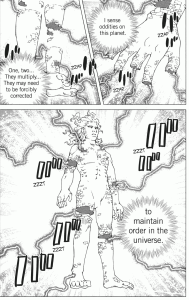 Resolution then can only come with Maelstrom, Horizon and Hikaru working together. The Evolution Moderator is then bemused by the new notion that he is not needed on all worlds.
Resolution then can only come with Maelstrom, Horizon and Hikaru working together. The Evolution Moderator is then bemused by the new notion that he is not needed on all worlds.
Overall, I’d say that 7 Billion Needles packs a SF punch that should not be missed. It’s a short work of only 4 volumes, but it reads as if it’s larger. I think it would make a very good gateway manga for those who have never read any. It balances action with the ordinariness of school. Evolution with the known SF elements of Clement’s work. The inscrutable Evolution Moderator with the basic emotions of the lead characters. Tadano, as a mangaka, is up to the challenge since he must draw for us such a wide variety of setting and situations. Since this was Tadano’s debut work, I have already put him on the list of authors I need to pay attention to.
Finding 7 Billion Needles is not a problem at all. It’s in print and widely available from our friends at Vertical. From brick-n-morter to your favorite online seller, you shouldn’t have any problems getting the series. But if you do find yourself without funds, you can read the series for free at mangatraders.com.



















 Full Details
Full Details
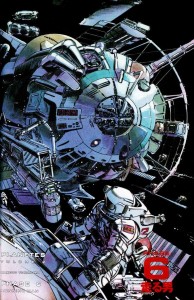



No comments yet.
Sorry, the comment form is closed at this time.